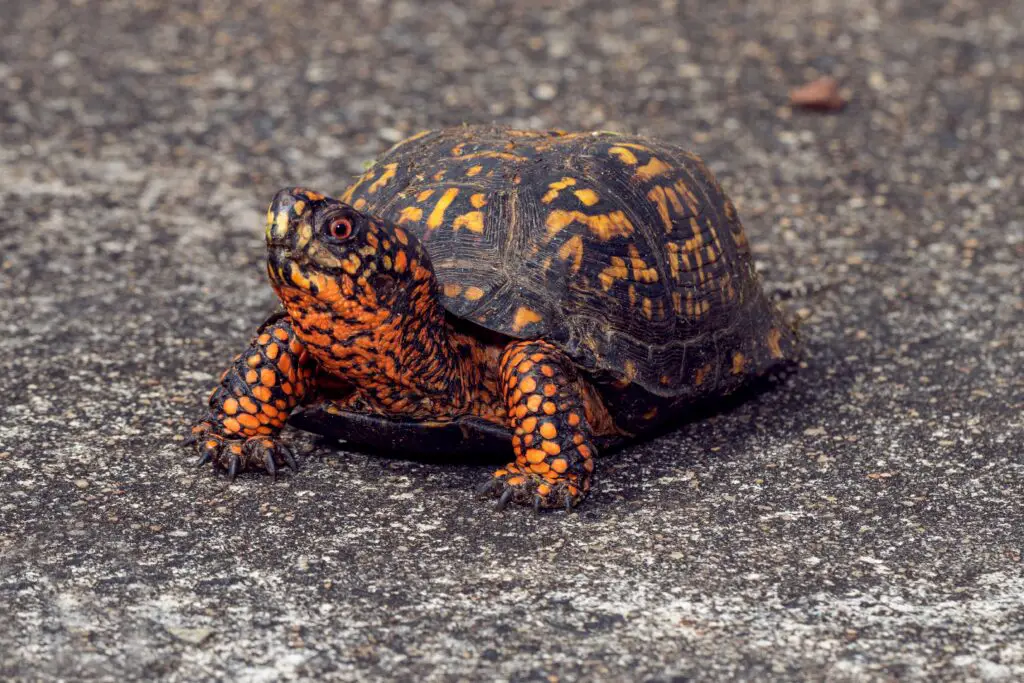How long does a box turtle live
How long does a box turtle live: Welcome, esteemed readers, to this enlightening article that delves deep into the captivating world of box turtles and their remarkable lifespan. Within the confines of their sturdy shells lies a tale of endurance and perseverance. These fascinating creatures have captured the curiosity and admiration of nature enthusiasts for generations, with their unique characteristics and ability to endure the test of time.
Definition and Characteristics of Box Turtles
 Box turtles belong to the family Emydidae, comprising several species under the genus Terrapene. These magnificent reptiles are highly adaptable, thriving in various ecosystems across North America.
Box turtles belong to the family Emydidae, comprising several species under the genus Terrapene. These magnificent reptiles are highly adaptable, thriving in various ecosystems across North America.
With a characteristic dome-shaped shell divided into two distinct parts – the carapace (upper shell) and plastron (lower shell) – box turtles possess exceptional protection against potential threats. Their shells exhibit a mesmerizing array of colors, ranging from earthy browns and greens to vibrant oranges and yellows.
This variation in coloration often correlates with their habitat surroundings, enabling them to blend seamlessly into their environment. Box turtles boast an average length of 4-8 inches, with males being slightly larger than females.
Fascination with Their Lifespan
How long does a box turtle live: The longevity achieved by box turtles has long fascinated scientists and wildlife enthusiasts alike. While many animals have relatively short lifespans in comparison to humans, box turtles defy this trend by living remarkably long lives. The prospect of these reptiles surviving for several decades intrigues us as we strive to understand what factors contribute to their impressive lifespan.
Furthermore, box turtle lifespan studies provide valuable insights into ecological health and conservation efforts. By unraveling the secrets behind their extended lifespans, researchers can better comprehend environmental impacts on wildlife populations while formulating strategies for protection and preservation.
This article seeks to shed light on the enigmatic world of box turtles, examining their defining characteristics and exploring the various factors that influence their lifespan. Join us on this captivating journey to uncover the secrets behind these remarkable reptiles’ endurance in the face of time.
Overview of Box Turtle Lifespan
The Enigma of Longevity
The lifespan of box turtles has intrigued scientists and nature enthusiasts for centuries. These fascinating creatures have the ability to live for an impressive span of time, typically ranging from 30 to 50 years in the wild. This enduring longevity sets them apart from many other reptiles and prompts us to delve deeper into understanding the factors that contribute to their extended lifespans.

A Slow and Steady Journey
Box turtles are known for their slow growth rate, taking several years to reach sexual maturity. Unlike mammals, whose metabolism accelerates during adolescence, box turtles maintain a steady metabolic rate throughout their lives.
This sluggish pace contributes to their prolonged existence, as they experience less wear and tear on their bodies over time. While some may view this as a hindrance, it is actually a remarkable adaptation that allows them to conserve energy and resources more efficiently.
The Role of Genetics and Species Variation
It is important to note that the lifespan of box turtles can vary depending on the species and individual genetics. For instance, Eastern box turtles (Terrapene carolina) are known for their relatively long lives, often reaching ages between 40 and 50 years. On the other hand, Three-toed box turtles (Terrapene carolina triunguis) tend to have shorter lifespans, averaging around 30 years.
Another species, the Ornate box turtle (Terrapene ornata), can live up to 40 years or more if provided with optimal conditions. Additionally, Desert box turtles (Terrapene ornata luteola) exhibit varying lifespans depending on environmental factors such as access to water sources in arid habitats.
Overall, while the general lifespan range for box turtles falls between 30 and 50 years in the wild, the specific duration can be influenced by genetic factors and species variation. The enigmatic nature of their longevity is closely linked to their slow growth rate, steady metabolism, and adaptation to their environment.
However, many other factors contribute to their longevity as well, including environmental conditions and the ability to overcome challenges throughout their life stages. In the subsequent sections of this article, we will explore these elements in more detail to gain a comprehensive understanding of what shapes the lifespan of these captivating creatures.
Factors Influencing Box Turtle Lifespan
Genetics and Species Variation
 Box turtles, with their diverse species and subspecies, exhibit considerable variation in terms of genetics, which in turn can influence their lifespan. One of the most well-known species is the Eastern box turtle (Terrapene carolina), which has a lifespan ranging from 30 to 50 years.
Box turtles, with their diverse species and subspecies, exhibit considerable variation in terms of genetics, which in turn can influence their lifespan. One of the most well-known species is the Eastern box turtle (Terrapene carolina), which has a lifespan ranging from 30 to 50 years.
These turtles are known for their intricate shell patterns and range across eastern parts of North America. Another notable species is the Three-toed box turtle (Terrapene carolina triunguis).
As the name suggests, they have three toes on their hind limbs instead of the usual four. With a similar lifespan to the Eastern box turtle, these turtles are found mainly in central parts of North America and thrive in open grasslands.
The Ornate box turtle (Terrapene ornata) is another fascinating species known for its vibrant coloration and intricate shell patterns. This species typically inhabits grasslands and shrublands and can live up to 30 years or more.
We have the Desert box turtle (Terrapene ornata luteola), a subspecies of the Ornate box turtle that is adapted to arid desert environments. Despite facing extreme heat and limited resources, these turtles can still live a considerable amount of time due to their unique physiological adaptations.
Environmental Factors
How long does a box turtle live: The longevity of box turtles is also influenced by various environmental factors, including habitat quality and availability. Forested areas provide an ideal habitat for many box turtle species as they offer ample shelter, food sources, and protection from predators. Conversely, urban environments pose significant challenges due to habitat fragmentation caused by human activities such as construction and deforestation.
This loss of suitable habitat leads to population decline among box turtles. Deforestation specifically impacts not only the availability but also the quality of habitats for box turtles.
Destruction of forests removes crucial nesting sites, disrupts food availability, and diminishes the overall biodiversity that these turtles depend upon. Moreover, climate conditions and temperature fluctuations play a vital role in the lifespan of box turtles.
Many species hibernate during winter months to conserve energy and survive harsh conditions. Hibernation patterns and the ability to adapt to temperature fluctuations are critical factors for their survival.
Changes in climate, including rising temperatures or unpredictable weather patterns, can have detrimental effects on their hibernation cycles and subsequently impact their lifespan. Genetics and species variation as well as environmental factors significantly influence the lifespan of box turtles.
Genetic differences between species like the Eastern box turtle, Three-toed box turtle, Ornate box turtle, and Desert box turtle contribute to variations in longevity. Furthermore, habitat quality and availability play a pivotal role with forested areas providing optimal conditions compared to urban environments impacted by deforestation.
Climate conditions such as hibernation patterns are also crucial in determining how long these remarkable creatures live. Understanding these factors is essential for conservation efforts aimed at preserving these magnificent reptiles for generations to come.
Life Stages of Box Turtles
Hatchlings and Juveniles
 The delicate beginnings of a remarkable journey Box turtles, like many other reptiles, start their lives as tiny hatchlings emerging from eggs laid by their mothers.
The delicate beginnings of a remarkable journey Box turtles, like many other reptiles, start their lives as tiny hatchlings emerging from eggs laid by their mothers.
Nesting habits vary slightly among box turtle species, but in general, female box turtles seek out well-drained sandy or loamy soil to dig a nest cavity. They use their hind legs to create a shallow hole and lay their eggs one by one before covering them with soil and vegetation to provide camouflage and protection.
The egg incubation period for box turtles can range from 60 to 90 days, depending on the environmental conditions. Temperature plays a crucial role: warmer temperatures often result in shorter incubation periods.
During this time, the developing embryos are entirely dependent on the conditions within the eggshell for survival. It is important for the nest to remain undisturbed, as any disturbance may disrupt proper embryo development.
Survival challenges during early life stages pose significant threats to hatchling and juvenile box turtles. The vulnerable young reptiles face numerous predators such as raccoons, snakes, birds of prey, and even larger adult turtles.
Additionally, they must navigate through unfamiliar terrain while searching for suitable food sources and shelter. Due to these challenges, only a small percentage of hatchlings reach adulthood.
Adult Life Stage
The prime years of power and reproduction Box turtles reach sexual maturity at varying ages depending on environmental factors like food availability and climate conditions.
Generally speaking, male box turtles become sexually mature between 4-10 years old while females typically mature slightly later at around 6-12 years old. Once they reach maturity age, reproductive behavior becomes prominent in adult box turtles’ lives.
During courtship rituals that can be observed primarily during spring or early summer months (varying slightly depending on the region), male box turtles actively pursue females. They may engage in head bobbing, circling, and biting behavior to demonstrate their fitness and interest.
Interestingly, sexual dimorphism is observable in box turtles. Males often exhibit traits such as larger size, concave plastrons (bottom shell) that fit over the female’s domed carapace (top shell) during mating, and brighter or more vibrant coloration compared to females.
These differences help distinguish between the sexes and play a role in courtship interactions. Understanding the life stages of box turtles provides valuable insight into their remarkable journey.
From delicate hatchlings emerging from carefully crafted nests to sexually mature adults engaging in courtship rituals, these turtles navigate a challenging path filled with survival obstacles and reproductive responsibilities. Appreciating their life cycle can further enhance our understanding of these fascinating creatures and contribute to efforts aimed at conservation and protection.
How Long Does a Box Turtle Live: Common Threats to Box Turtle Lifespan
Human activities
Humans, often unintentionally, pose significant threats to the longevity of box turtles. One of the primary concerns is habitat destruction due to urbanization.
As cities expand and natural habitats are encroached upon, box turtles lose their essential shelter and foraging areas. The destruction of forests and meadows leaves these reptiles vulnerable, as they heavily rely on diverse environments for survival.
Furthermore, the fragmentation of their habitats can isolate populations and inhibit gene flow among them. Another perilous human-driven threat is road mortality from vehicle collisions.
Box turtles are known for their slow movements and limited agility when crossing roads. They frequently fall victim to speeding cars that fail to notice them in time.
Tragically, even surviving a collision can result in severe injuries that may lead to an early demise due to infections or impaired mobility. Moreover, the illegal pet trade exacerbates the challenges faced by box turtles in their struggle for survival.
These enchanting creatures are often captured from the wild and sold as exotic pets without consideration for their natural needs or well-being. Such practices not only disrupt wild populations but also undermine conservation efforts aimed at protecting these precious reptiles.
Predators
In addition to human-induced threats, box turtles face predation from various animals within their native ecosystems. Native predators like raccoons, skunks, foxes, and even some birds view box turtles as potential sources of food.
Juvenile turtles are particularly vulnerable to predation due to their small size and relatively weaker defense mechanisms compared to adults. While these predators play a crucial role within ecosystems by regulating prey populations, the increased pressure they exert on already dwindling turtle populations further threatens the longevity of box turtles.
To Sum Up How Long Does a Box Turtle Live
The long-term survival of box turtles is undoubtedly threatened by multiple factors, including habitat destruction, road mortality, the illegal pet trade, and predation by native animals. However, amidst these challenges lies the potential for positive change. By raising awareness about the importance of preserving natural habitats and implementing measures to reduce road mortality rates through signage or turtle-friendly underpasses, we can mitigate some of these threats.
Furthermore, education and enforcement efforts focused on discouraging the illegal pet trade can help protect box turtles from being exploited for profit. By respecting the delicate balance of nature and taking actions to conserve these remarkable creatures’ habitats and populations, we can ensure a brighter future for box turtles and their enduring presence in our ecosystems.
Further Reading
How To Keep My Turtle Tank From Smelling
How To Decorate a Turtle Tank: DIY Guide


